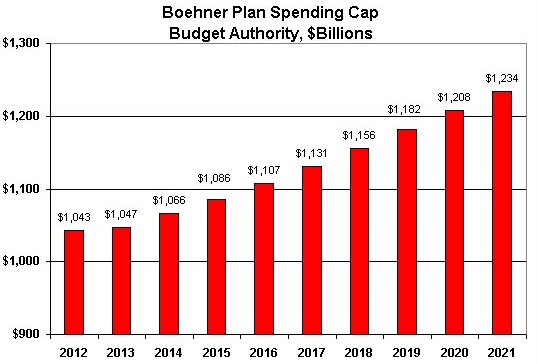July 27, 2011
Chris Edwards complains that John Boehner’s plan for spending cuts “doesn’t actually cut spending at all.” So says his chart.

Unfortunately Edwards chooses to report budget authority rather than outlays—the actual cash flow. Under Boehner’s plan, outlays (still net of spending “in Afghanistan and Iraq”) rise only from $1.262 trillion to $1.278 trillion. Rather than an apparent 18 percent increase, the rise in outlays is less than 1.3 percent.
More importantly, however, these numbers are not adjusted for inflation. According to projections by the Congressional Budget Office, inflation will rise at least 18 percent from 2012-21. Thus, Boehner’s plan has real outlays falling by more than 14 percent by 2021.
[UPDATE]
Chris Edwards is repeating himself. Not that there is anything wrong with that. But he is still wrong.
Boehner’s amended proposal was scored by CBO as saving an additional $46 billion over the first two years, and guess what? As a result of those deeper cuts, spending goes up even faster than before! Rather than an increase in outlays of 1.3 percent (not adjusted for inflation) outlays now increase 3.0 percent.
Maybe, just maybe, Edwards has a ridiculous way of thinking about spending cuts.
[UPDATE 2]
What? Did you say that stuff costs more today than it did a couple years ago? Maybe somebody really ought to tell Chris Edwards over at Cato. For the third time in only a few days, Edwards showed a chart of Speaker Boehner’s proposed discretionary budget authority and forgot to adjust for inflation.
At last check, Boehner proposed that by 2021 the government spend 14.9 less on discretionary outlays when adjusted for consumer prices.
If you fail to take prices into account, you might wind up saying ridiculous things like private spending was 10.1 percent higher in April through June than it was when Barack Obama took office. Or you might say that despite the loss of millions of jobs, Americans managed to “produce” 8.0 percent more.
If you fail to account for inflation, then the economy grew 57 percent under Jimmy Carter—a whopping 12 percent per year! By Edwards’ measure, national income grew more rapidly under Carter’s presidency than in any four-year period since the end of World War II.






